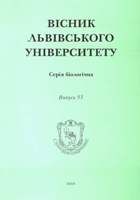

 | Наукова періодика України | 
| Вісник Львівського університету |
Kata I. The possibility of disposing of waste glycerol using metabolic engineering / I. Kata, M. Semkiv, K. Dmytruk, A. Sibirny // Вісник Львівського університету. Серія біологічна. - 2016. - Вип. 73. - С. 249. - Режим доступу: http://nbuv.gov.ua/UJRN/VLNU_biol_2016_73_59 Transesterification reactions using animal fats, vegetable oils and alcohols cause the formation of biodiesel. This process unavoidably generates large amounts of glycerol as a by-proіduct. The availability of crude glycerol is predicted to be increased during next years due to tremendous growth in the production of biodiesel worldwide. To maximize the full economic potential of the biodiesel process, it is important to convert crude glycerol into useful chemicals, e.g. ethanol. Glucose fermentation is efficiently carried out by microbes though there are few microorganisms that are able to convert glycerol to ethanol. Therefore, the tools of metabolic engineering along with classical selection should be used for construction of the recombinant strains with improved ethanol production. Conversion of glycerol to ethanol is used by thermotolerant yeast Ogataea (Hansenula) polymorpha, which convert glycerol to ethanol on both glucose and xylose. The idea of this work was to improve production of ethanol from glycerol using thermotolerant methylotrophic yeast O. polymorpha. For this, the vectors for multicopy integration of both PDC1 (encodes pyruvate decarboxylase) and ADH1 (encodes alcohol dehydrogenase) genes under control of strong constitutive promoter of glyeraldehyde-3-phosphate dehydrogenase gene have been constructed. Obtained recombinant strains of O. polymorpha with overexpression of both PDC1 and ADH1 revealed increased specific activities of both Pdc1 and Adh1 and ethanol production. In addition, optimization of fermentation conditions resulted in the accumulation of the higher amounts of ethanol from glycerol (up to 5 g/L). The next steps of our work are based on overexpression of genes encoding enzymes of the initial reactions of glycerol catabolism. O. polymorpha can use two pathways of glycerol catabolism. First one involves the GCY1 (encoding glycerol dehydrogenase) and DAK1 (encoding dihydroxyacetone kinase), while the alternative pathway is consists of GUT1 (encoding the glycerol kinase), and GPD1 (dehydrogenase of glycerol-3-phosphate). The corresponding vectors pUC19/GAPpr-GPD1-GAPtr/NTC and pUC19/GAPpr-GCY1-GAPtr/NTC were constructed and transformed into yeast cells. As a host strains the wild-type strain and strains NCYC/PDC1 (with overexpressed PDC1) and NCYC/PDC1/ADH1 (with overexpressed of PDC1 and ADH1) were used. The newest data of glycerol conversion to ethanol by recombinant strains will be discussed. Цитованість авторів публікації: Бібліографічний опис для цитування: Kata I. The possibility of disposing of waste glycerol using metabolic engineering / I. Kata, M. Semkiv, K. Dmytruk, A. Sibirny // Вісник Львівського університету. Серія біологічна. - 2016. - Вип. 73. - С. 249. - Режим доступу: http://nbuv.gov.ua/UJRN/VLNU_biol_2016_73_59.Додаткова інформація про автора(ів) публікації: (cписок формується автоматично, до списку можуть бути включені персоналії з подібними іменами або однофамільці) |
|
|
Всі права захищені © Національна бібліотека України імені В. І. Вернадського |
|||||